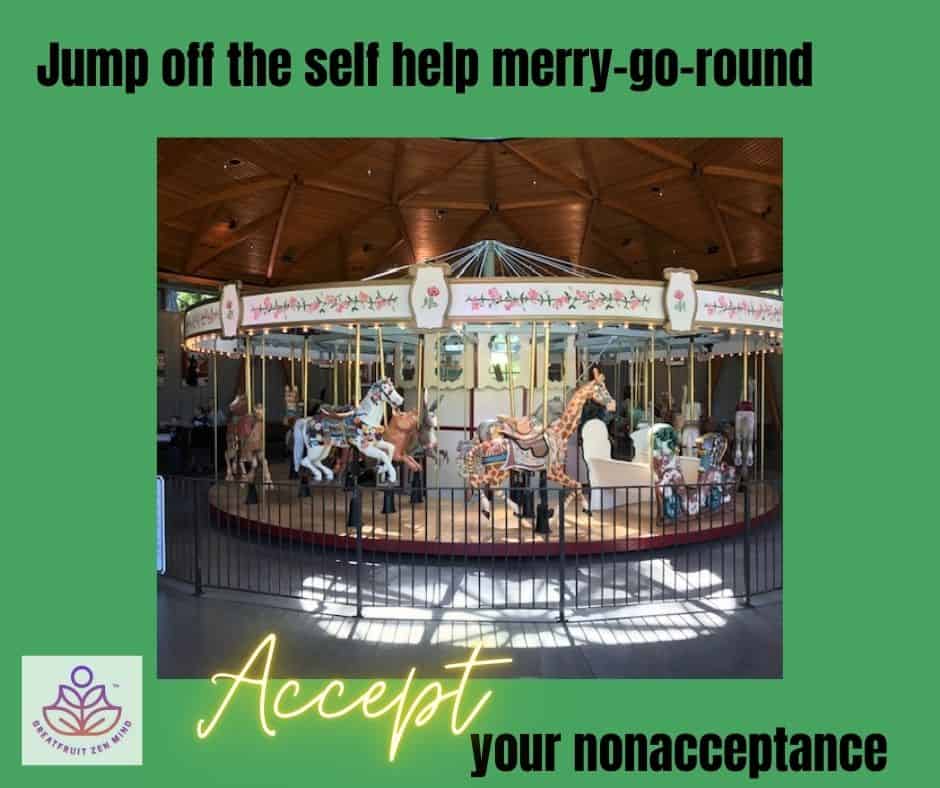Read time 4 minutes. Nonacceptance is a stand alone article in our series regarding Acceptance.
Today we continue the discussion of radical acceptance, and what we find may be unsettling. Zen suggests that acceptance is the goal, but paradoxically, the entry point is nonacceptance. It is only by becoming intimate with our refusal to accept that the practice of acceptance begins to open.
In the last lesson, I suggested we start small—not by attempting universal acceptance all at once, but by accepting the fact that we are unwilling. That step backward is, in truth, the most honest step forward.
Nonacceptance and not-doing
Charlotte Joko Beck writes:
“You can’t try to fix yourself. You can’t try to be an accepting person. What you can do is experience not accepting something. How many minutes can I just sit and be that?… The more we experience, the less we need things to be different. The less attached we are to judgment.”
Here Beck lays out the essence of practice. Not fixing. Not striving to be an accepting person. Simply sitting with nonacceptance as it is. This overturns our usual instinct—to try harder, to improve, to force growth. But practice is not improvement. Practice is presence. And presence does not begin in imagined perfection, it begins in what is actually here.
The question then becomes: how do we experience nonacceptance?
Experiencing nonacceptance
Beck again offers guidance:
“When you are truly experiencing, you are not feeding the suffering or the anger; you are it. And I say, ‘Be what you are.’ The word experiencing confuses people. Experiencing doesn’t mean something fancy. It doesn’t mean anything more than, for just a second, being without the thought.”
To experience means to let thought fall away—even for a second—and meet the emotion directly. No narrative. No convincing ourselves to accept. Just allowing the anger, the impatience, the refusal.
Oddly, this immersion in nonacceptance often opens, however briefly, into a universal acceptance. But the true transformation is not the feeling that follows—it is the shedding of the ego in the moment of pure experience. We are not trying to become nonacceptance or emotion. We are not trying to become anything. The practice is simply allowing the false self to fall away so that our true nature, as Tao, stands unobstructed.
Choosing the difficult
This is not easy. As Beck says:
“Going into real experiencing can feel like a tremendous loss. And it is a loss. It’s a loss of who we believe we are. We lose what we think is our identity…. But what we’re afraid of is that we have to give up our ideas about ‘I’m this; I’m that. I have to do this; I have to do that. He doesn’t love me; it’s a terrible life.’ In experiencing, there is none of that.”
No wonder we hesitate. Thoughts are exhausting, even dreadful—yet they are familiar. We cling to the familiar prison because the unknown feels riskier. As Beck puts it, we are “more fascinated with being hungry rather than with satisfying (our) hunger.”
Practice, then, is not about chasing peace or acceptance. It is about turning directly toward discomfort, disappointment, expectation. Not to fix them, but to experience them. Only this kind of investigation uncovers a peace that cannot be manufactured.
Experience as flow
Beck summarizes:
“The more your life experience develops and refines this kind of clarity, the more you realize that awakening isn’t something you look for, it’s something you are. It will be perfectly clear to you that awakening is, finally, nothing but being largely free of this self-centered dream that we cook up.”
Awakening is not a distant prize. It is the recognition of what remains when the dream of identity drops away.
We believe our narratives are real. But they are illusion. And what feels like letting go of reality is only letting go of a false self. This lesson is not just about radical acceptance—it identifies the center of practice itself. Identity becomes the fulcrum, like a teeter-totter, shifting back and forth until balance is struck.
Honest vision
Zen has never promised ease. Beck’s teachings cut through illusions without sugarcoating. And that bluntness is not unlike the image of the stern Zen master giving his student a sharp rap to awaken him. Practice is not comfortable, but it is clarifying.
As we continue, Beck’s framing of nonacceptance as practice will remain a guide. If we can stay with what is real—even when it feels like loss—we may begin to see what freedom actually means. Read more about the life and work of Charlotte Joke Beck at Ordinary Mind.
Choose your own adventure:
- 📖 Zen Seed: Rhett Butler—SexyIndifference OG →
- 🍉 About Us: Watermelon Soup For The Soul →
- ⚓️ Go Deeper: The Undercurrent Signup →
- 🛍️ Shop Around: Visit the GZM Store →
- 🦋 Do Nothing, See What Happens: Mini Practice→
- 🌀 Linger: Go to Homepage →
- 🔁 Follow Along:
Photo by Angie Fritz
🌀 From the GZM Archives – Polished, Preserved, Still Relevant.


Leave a Reply